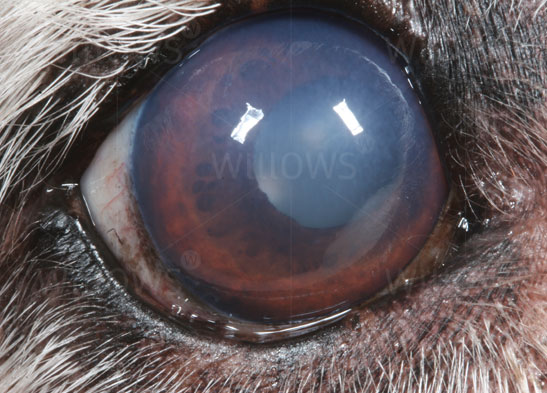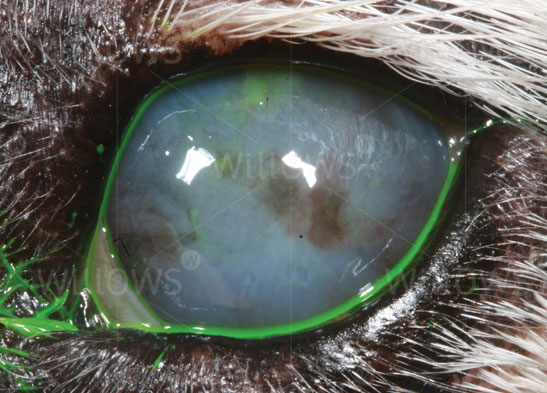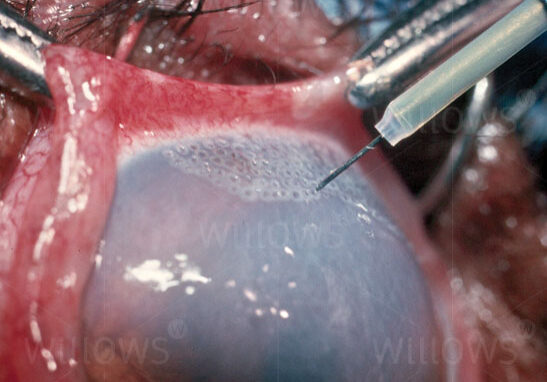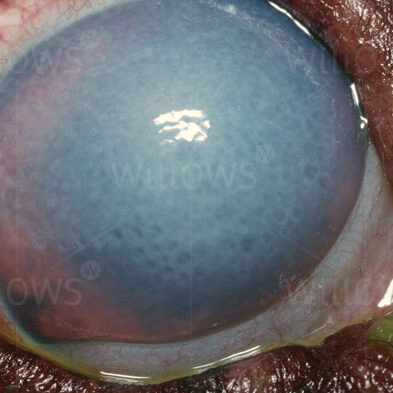Why Should I Bring my Pet to Willows for Senile Endothelial Degeneration?
Willows is one of Europe’s leading small animal referral centres. Our state-of-the-art hospital is led by internationally renowned Specialists, committed to providing the highest standards of veterinary care. Our Specialist Ophthalmologists are supported by our multi-disciplinary team of Specialists across a number of different disciplines including; Anaesthesia, Diagnostic Imaging and Emergency and Critical Care.
Willows also has a large dedicated team of Vets, Nurses and clinical support staff available 24 hours a day, every day of the year to provide the best possible care for your pet.

What is Senile Endothelial Degeneration (Cornea Oedema)?
Senile endothelial degeneration is a corneal condition that occurs in older dogs. The normally clear cornea (the clear front surface of the eye) becomes water-logged and swollen, this is called corneal oedema. It makes the surface of the eye look blue or cloudy, similar to a steamed-up window. The blueness is often mistaken for cataract which is very different – a cataract is when the lens deep inside the eye goes cloudy.
Fig 1: Mild corneal oedema in a Golden Retriever, making the cornea appear ‘steamy’


What is the cause of Senile Endothelial Degeneration?
The cornea is the clear transparent window at the front of the eye. In order to be transparent, the inner lining of the cornea (endothelium) has thousands of tiny ‘pumps’ that keep water out. With age the number of pumps naturally decreases. In most dogs, the eyes compensate and no problems occur. However, in some dogs, the number of pumps falls to a critical level and so corneal oedema develops.
Fig 2: Advanced degeneration of the cornea. Ulcers have developed (stained green using a special dye) causing blood vessels and brown pigment to invade the cornea.
What are the Signs of Senile Endothelial Degeneration?
In the early stages, corneal oedema causes visual impairment as the clear window at the front of the eye is cloudy or ‘steamed up’, there is no pain at this stage. With time, the water-logged cornea becomes over saturated, and small ‘blisters’ form on the surface. These blisters burst spontaneously from time to time and cause small ulcers. These ulcers cause pain, which in turn causes symptoms such as blinking, squinting, weeping and light-shyness.
How is Senile Endothelial Degeneration Diagnosed?
This condition is diagnosed with a full ophthalmic examination by our Ophthalmology Specialist team, including slit lamp biomicroscopy, indirect ophthalmoscopy, ocular tonometry, and a diagnostic contrast agent for staining of the cornea.
What treatments are available for Senile Endothelial Degeneration?
Treatment is usually only suggested if the cloudiness is very noticeable and/or there is pain from ulcers forming in one or both eyes. There are three main treatment options available:
Conservative medical treatment:
- Antibiotic and lubricating eye ointments and painkiller tablets; designed to reduce irritation and prevent infection until the ulcer heals
- Special salt eye ointment (sodium chloride ointment); applied up to four times daily to draw water out of the water-logged cornea.
Surgery:
- Thermokeratoplasty to stop the ulcers forming
Surgery does not unfortunately reduce the cloudiness of the eye, and in some cases it can make it slightly worse, as such surgery is usually only recommended in advanced cases where the cornea is already very cloudy and recurrent ulcers are causing pain.
The procedure carried out under general anaesthetic involves the application of multiple, pinpoint burns to the surface of the cornea. The burns stimulate the surface of the eye to form a layer of scar tissue which then reduces the risk of ulcers forming. At the end of the procedure, the surgeon will usually place a contact lens on the surface of the eye to help the healing process and make the eye more comfortable. Following the surgery, the operated eye is usually comfortable, but if the contact lens falls out early on, some dogs will only partially open the eye for a few days.

Fig 3: An eye undergoing Thermokeratoplasty under general anaesthesia.
What can I Expect if my Pet is Treated for Senile Endothelial Degeneration?
Following surgery, your dog may need to wear a collar to prevent damage to the eye(s) that may be caused by rubbing or scratching. Gentle cleaning of the eye with wet cotton wool twice a day is recommended. An antibiotic drop or and atopical lubrication are generally applied to the eye for ten days following surgery. A short course of antibiotic tablets and painkillers may also be prescribed.
Thermokeratoplasty is a very successful surgery in uncomplicated cases, and the operation is commonly carried performed by the Specialist Ophthalmology team at Willows. Surgery aims to bring eye pain to an end rather than improving vision.
Fig 5- An eye which has healed following thermokeratoplasty.

To save this page as a PDF, click the button and make sure “Save as PDF” is selected.
Ophthalmology
Find out more
To assist owners in understanding more about Ophthalmology we have put together a range of information sheets to talk you through the some of the more common conditions seen and treated by our Specialists.

